|
Wild Roses |
| Kingdom |
:
|
Plantae– Plants |
| Subkingdom |
:
|
Tracheobionta– Vascular plants |
| Superdivision |
:
|
Spermatophyta– Seed plants |
| Division |
:
|
Magnoliophyta– Flowering plants |
| Class |
:
|
Magnoliopsida– Dicotyledons |
| Subclass |
:
|
Rosidae |
| Order |
:
|
Rosales |
| Family |
:
|
Rosaceae– Rose family |
| Genus |
:
|
Rosa L.– rose |
|
Species of
this genus native to the Pacific
Northwest: Washington, Oregon,
California and some Canadian Provinces |
| Rosa
L. |
Rose |
| Rosa
californica Cham. & Schltdl. |
California Wildrose |
| Rosa
canina L. |
Dog Rose |
| Rosa
eglanteria L. |
Sweetbriar Rose |
| Rosa
gymnocarpa Nutt. |
Dwarf Rose |
| Rosa
micrantha Borrer ex Sm. |
Smallflower Sweetbrier |
| Rosa
multiflora Thunb. |
Multiflora Rose |
| Rosa
myriadenia Greene, nom. inq. |
Glandular Rose |
| Rosa
nutkana C. Presl |
Nootka Rose |
| Rosa
nutkana C. Presl var.
hispida Fernald |
Bristly Nootka Rose |
| Rosa
nutkana C. Presl var.
muriculata (Greene) G.N. Jones |
Nootka Rose |
| Rosa
nutkana C. Presl var.
nutkana |
Nootka Rose |
| Rosa
pisocarpa A. Gray |
Cluster Rose |
| Rosa
spithamea S. Watson |
Ground Rose |
| Rosa
spithamea S. Watson var.
spithamea |
Ground Rose |
| Rosa
woodsii Lindl. |
Woods' Rose |
| Rosa
woodsii Lindl. var.
ultramontana (S. Watson) Jeps. |
Woods' Rose |
| Rosa
yainacensis Greene |
Cascade Rose |
|
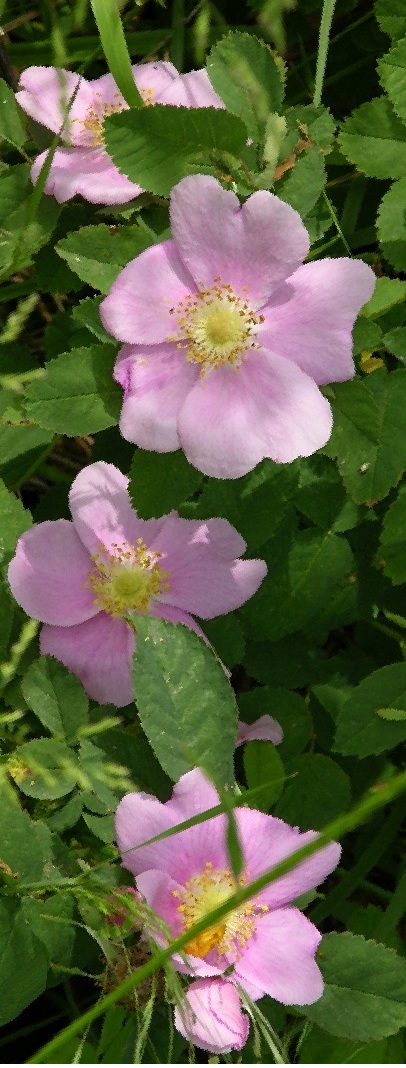 |
|
Species Information For This Genus
Click on links below on this page for
photos and details of each plant. |
|
As yet, not all northwest native
roses are covered in this website, though that may be done some time in the
future. For now, we have information about only four of our northwest native
roses.
Note:
Throughout the years I've written short articles for our
website's home pages (home pages are the front page of a
website) about these plants. They are now included at the bottom
of this page, and are illustrated by botanical drawings and
paintings, some of which are from books published from 1500 -
1900. |
|
|
Rosa gymnocarpa (Bald-Hip Rose, Little Wild Rose)
This beautiful native rose is slender and delicate. It grows rapidly to 3-5'
and is adorned with tiny 1" pink flowers with single petals in attractive
clusters.
The foliage is fine, even lacy and the branches are bristled rather than
thorned.
The naked hips are a brilliant red and remain on stems throughout winter.
This rose is native to the Pacific Coast in shady, moist locations. It will
not, however, tolerate waterlogged soils. It is hardy from USDA zones 7-9. |
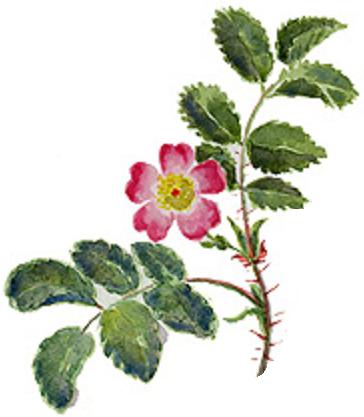 |
|
Rosa nutkana (Nootka Rose)
This delightful native rose has large, bright, orange hips and clusters of
one to three 2" pink flowers with a sweet, almost cinnamon scent.
Nootka Rose grows very fast, reaching 3-6' and spreading by suckers to form
dense thickets, where birds seek shelter and build their nests.
Found from Alaska to California and east to Utah and Colorado, Nootka Rose is
hardy from USDA zones 4-9. It likes moisture, but not boggy conditions, and full
sun.
It is a border plant, found where the forest meets the field, road or sea
shore. |
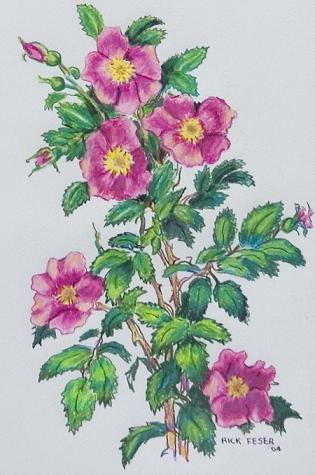 |
|
Rosa pisocarpa (Clustered Rose, Peafruit Rose)
A beautiful native rose that has several clustered instead of solitary pink
flowers. It blooms from May-July and often for a second time in fall. The
leaflets are sharply pointed and have hints of blue, while the branches are long
and arch gracefully. They are armed with vicious thorns, providing birds and
small wildlife a safe haven from predators.
A riparian species, the Clustered Rose loves moist, even waterlogged, soils
and will grow well in a wet garden where other roses would fail. It is found
along the Pacific Coast to the Cascade Mountains, USDA zones 7-8.
This is a superior variety for crafters and lovers of rosehip jelly as the
yield of rosehips are immense! Save some for the birds, though! |
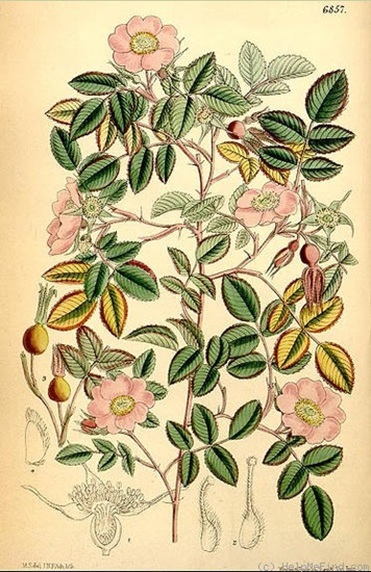 |
|
Rosa woodsii (Wood's Rose)
A superb native rose, Rosa woodsii has rose-pink flowers in early June.
The bright red hips persist throughout winter, and are used as food by birds.
A fast grower, the Wood's Rose quickly reaches 4.'
It is the hardiest of the natives roses I carry, surviving in the harsh
conditions from the Rocky Mountains through the Cascades, USDA zones 4-6.
It is drought tolerant, needs little sun and can survive on steep, rocky
slopes with little topsoil. An excellent choice for difficult sites. |
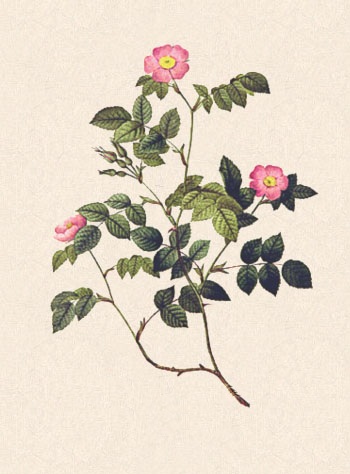 |
 |
From Homepage February 5,
2005
Claude
Monet, one of the foremost impressionist painters, found great delight
in simple roses. He was particularly fond of the native roses - the pure
color (pink) - the beauty in the pure simplicity (single petal flowers -
several petals of course but not doubled in multiple layers).
Carefree native roses: a Monet Rose garden
would be a lovely addition to your landscape.
This summer when the your native roses are
blooming, you can stand amidst them and close your eyes. Breathe in
their delicious perfume. Imagine you are at Giverny. You might even find
the urge to try your hand at capturing their essence on canvas to
remember that summer day in your rose garden. |
|
Plant wild roses in combination with the
Western Snowberry (Symphoricarpos occidentalis)
for a beautiful winter presentation. The red rose hips and the white
Snowberries will delight you and your wildlife visitors all winter.
Create an island or corner garden with
Serviceberry (Amelanchier alnifolia)
surrounded by NW Native roses. The white Serviceberry blooms are
followed by delicious berries. They're so good they're even grown as a
commercial crop in Canada! Prefer yellow blooms? The
Black Twinberry (Lonicera involucrata) is a
repeat bloomer that often presents the lovely yellow flowers with the
glossy black berries at the same time, sometimes on the same branch! |
|
From Homepage May 22, 2004
Nothing beats a wild rose for simple, sweet blooms. As I drive down
country roads, the fence rows have become bowers of pink roses. The
fragrance is pure and delightful. I know later in the year the blooms
will fade, each one leaving behind a red berry-like rosehip. A pleasure
to see and delicious to eat. The birds agree!
Though the birds don't bother to wash their food before eating, human
beings must be more cautious--always clean foods carefully. It's best to
grow your own wild roses, and refrain from using pesticides or other
poisonous chemicals that are not safe for any living thing.
 |
To a Wild Rose Found in October
By Ednah Proctor (Clarke) Hayes 1677
THOU foolish blossom, all untimely blown!
Poor jest of summer, come when woods are chill!
Thy sister buds, in June’s warm redness grown,
That lit with laughter all the upland hill,
Have traceless passed; save on each thornëd stem
Red drops tell how their hearts, in dying, bled.
Theirs was the noon’s rich languor, and for them
The maiden moon her haloed beauty spread;
For them the bobolink his music spilled
In bubbling streams; and well the wild bee knew
Their honeyed hearts. Now bird and bee are stilled;
Now southward swallows hurry down the blue,
Fleeing the murderous Frost that even now
Hath smote the marshes with his bitter breath,
Quenching the flames that danced on vine and bough,—
Think’st thou thy beauty will make truce with Death,
Or hold in summer’s leash his loosened wrath?
See! o’er the shrunk grass trail the blackened vines;
And, hark! the wind, tracking the snow’s fell path,
Snarls like a fretted hound among the pines.
The pallid sunshine fails,—a sudden gloom
Sweeps up the vale, a-thrill with boding fear.
What place for thee? Too late thy pride and bloom!
Born out of time,—poor fool,—what dost thou here?
What do I here when speeds the threatening blight?
June stirred my heart, and so June is for me.
Who feels life’s impulse bourgeon into light
Recks not of seasons, knows not bird nor bee.
I can but bloom,—did the June roses more?
I can but droop,—did they not also die?
The Moment is: the After or Before
Hides all from sight,—canst thou tell more than I?
What matter if to-night come swirling snow
And Death? The Power that makes, that mars, is One.
I know nor care not: when that Power bids blow,
I ope my curlëd petals to the sun.
|
 |
Painting (above left and right) "Study of Wild Rose" by John Ruskin
|
|
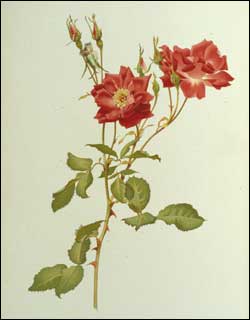
Painting by Alfred Parsons |
From Homepage October
27, 2006
Northwest native roses are
such little show-offs! They are so sweet in the early summer with their
baby pink blooms and their delicate fragrance that reminds one of
grandma's linen closet. Then the petals fall to reveal hips that are
oblong or round, turning scarlet and orange and even gold around
September. But did you know the Nootka Rose (Rosa nutkana) foliage is
also colorful? Shades of wine and pumpkin--so beautiful!
If your garden needs some
color for fall, consider northwest native wild roses. Beautiful and very
attractive to birds and butterflies. Add a few
Snowberries (Symphoricarpos albus) or Western
Snowberries (Symphoricarpos occidentalis). Planted together they are
just charming all year, especially in winter when most gardens could use
a bit of interest. The red rosehips and the white Snowberries will last
through the winter until the birds eat them all, every last one. |
|
|
|




